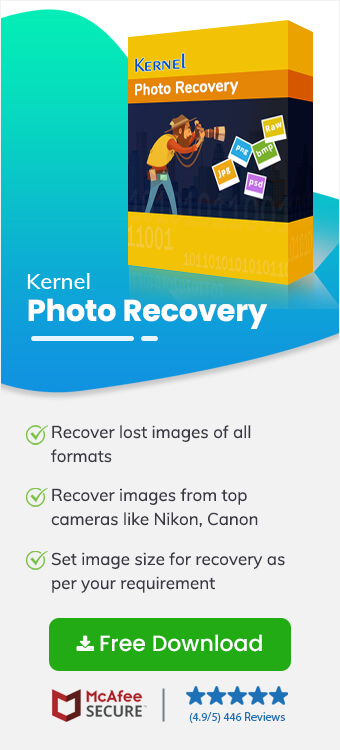Read time 5 minutes
Accidental deletion or drive formatting are the two leading causes of data loss. Be it an internal drive or an external storage device such as an SD or a compact flash (CF) card, accidents do happen and might leave you unnecessarily distressed. These days, most professional cameras come with an SD or CF card slots for storing the captured photographs; this allows the user to store large amounts of data (especially in the case of CF cards). When you delete a file or a folder, in the file index, the space occupied by that folder/file will be marked as empty, so that new information can be written on it. Formatting is similar to deletion in the sense that formatting erases all the data on the drive, all at once.
The system usually does not overwrite the space previously taken by a now-deleted file; it merely marks that space as ‘available.’ The system will never overwrite on this ‘available’ space unless it runs into low disk space; in that case, only it will overwrite on this ‘available’ space. Till then, there is always a scope for the recovery of deleted data.
Common reasons for data loss from CF cards
- Accidental deletion or formatting of drive: It is one of the reasons for loss of photos . Sometimes the deletion can be intentional too and formatting of the drive is another reason for the data loss.
- Physical damage: physical damage to the device in which the memory card is inserted can in-turn harm the memory card.
- Damaged hardware: You may have received a faulty memory card from the vendor . Some firmware damage can be the result of virus or a malicious attack also.
- Improper handling of the device: Improper handling of CF cards such as improper ejection of the storage device, can corrupt the photos stored on the device and cause consequent data loss.
- Storage issues: If the memory card is running out of space, then it can lead to the automatic deletion of photos and even give rise to corruption.
- Virus or malware attack: A virus or a malware attack can overwrite the data on your storage device and can severely corrupt your photos.
Tips to prevent CF card damage
It is essential that users make a habit of the practices given below to reduce the likelihood of corruption in CF cards and avoid potential data loss. Some tips to prevent data loss in CF card are:
- Take frequent backups: Taking routine backups of your photos ensure that in case of any unfortunate scenario, users won’t lose their valuable data.
- Proper storage: Ensure that your CF card is stored properly in a safe case with a stable temperature which is neither too hot nor too cold to prevent any physical damage.
- Format occasionally: Formatting your CF card routinely reverts it back to its factory setting, ensuring that your CF card remains in a good condition.
- Dedicated CF card: Using a single CF card for several devices can give rise to corruption which may lead to data loss. It is advised to use a CF card for one device only.
Methods to restore photos from a CF card
There are a few ways to restore photos from a CF card even if it’s damaged or corrupted. Some of them are explained below.
Method 1: Perform CHKDSK
CHKDSK utility is a splendid option to repair minor errors or corruption in bad sectors of corrupted drives. Users can perform this method to try and repair their CF card. Follow the steps below to initiate this process:
- Connect your CF card to your system.
- Press Windows + X and choose Command Prompt (Admin) from the list.
- Type chkdsk X: /f in the Command Prompt. The ‘X’ here represents the drive where your corrupt photos are saved.
- Wait for the process to be completed successfully. It may take some time considering how large your CF card is in size.
- Check to see if you can restore your photos or not.
Method 2: Restore photos from a CF card through backup
Photos can be easily restored from a CF card if you’ve a pre-existing backup saved at a different location. Backups are essential to avoid the possibility of data loss due to any unforeseeable scenarios like corruption or accidental deletions.
Method 3: Restore photos from a CF card by an automated tool
Recovering lost photos from a CF card can get tricky if you don’t have a backup at a safe location. For a safe and instant solution to restore your photos, try using Kernel Photo Recovery. It recovers photos in JPG, BMP, TIF, PNG, GIF, RIFF & many other formats. To recover those image files, it runs a deep scan of the drive. It also gives you the freedom to preview image files before saving them.
Moreover, it lets you set the picture size for recovery. It can recover photos not only from internal HDDs but also from external flash drives, SSDs, CF and SD cards. Most of the popular camera makers such as Canon, Nikon, Fuji Film, Minolta, and Kodak, have their own formats such as CRW, NEF, RAF, MRW, & DCR, etc. Kernel Photo Recovery tool supports these formats too.
Conclusion
Corruption or accidental deletion in CF cards can lead to loss of valuable photos. We’ve described a few practical ways to recover your lost photos. However, if you need to recover photos quickly without worrying about data loss, we recommend taking the help of Kernel Photo Recovery. This tool easily recovers permanently deleted photos and saves the recovered photos at your chosen location.







